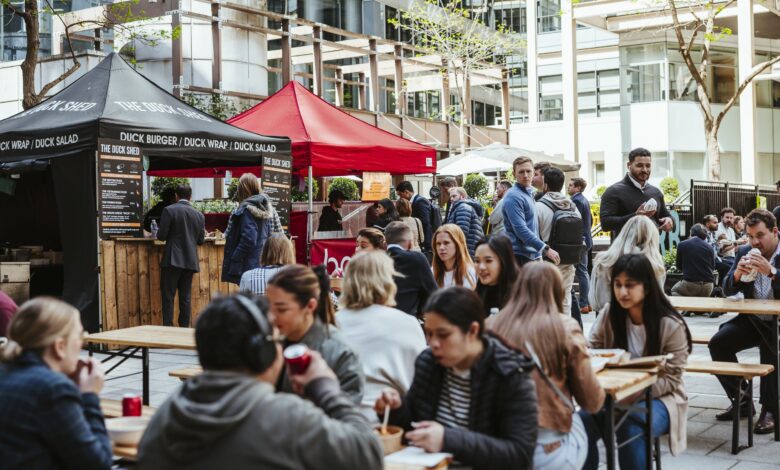The future of food halls: why Kerb is appealing to indie street food traders
It is beginning to look like more and more chefs are skipping the traditional restaurant route, opting instead to set up shop in shared spaces with built-in crowds

The traders at Kerb made more than £32m last year. That’s 37% higher than 2023. In just two years, their collective revenue has nearly doubled. For a group once seen as just an ensemble of scrappy street food vendors, the numbers tell a different story now.
Kerb is not alone. Market Halls has recently bought Shelter Hall on Brighton’s seafront from Sessions in a multi-million-pound deal, which kicked off what the brand hopes is the first of many acquisitions outside London. Could all this activity within the street food segment be something to keep an eye on?
It is beginning to look like more and more chefs are skipping the traditional restaurant route, opting instead to set up shop in shared spaces with built-in crowds, lower overheads and shorter leases. Given the fickle nature of consumer demands and changing tastes, the risks are lower and the rewards higher when you don’t spread yourself too thin.
The growth Kerb has seen is a story about numbers, yes. But it’s also a story about business growth on the bones of community, culture, and food. Kerb started on London’s streets. At the centre of its operations is Seven Dials Market, where 20 food businesses work side-by-side. In 2024, they served roughly 30,000 people a week and reached £17.5m in food sales alone – up 20.6% from the previous year.
Kerb still runs five weekly pop-up markets as well. Although at a much smaller scale, they are proving to be steady – having raked in £1.1m in revenues in 2024, up by 13%. The growth is real, and it’s speeding up.
Kerb Events, which runs food at the National Theatre, sports venues like Aston Villa, and private functions across the city, moved even faster. In a year, trader sales in the events arm jumped 69% to reach £13.6m. Street food has come a long way, and Kerb is proof it can go further.
As Kerb and Sessions have shown, food halls are a springboard, a way to prove the product to then push it into new formats: high streets, delivery kitchens, retail shelves.
Meanwhile, Sessions sold Shelter Hall to Market Halls in a pivot that saw the group turn its energy toward franchising and brand growth. Opened on Brighton’s seafront in 2020, Shelter Hall was sacrificed as part of Sessions’ new goal: to become the UK’s largest food hall operator.
As Kerb and Sessions have shown, food halls are a springboard, a way to prove the product to then push it into new formats: high streets, delivery kitchens, retail shelves. One always supersedes the other. The difference is where Kerb is expanding through place, Sessions is expanding through product. And yet, both are betting on what comes next.
Food halls are growing – and thriving – because from the street level, they look like fun. Crowds, choice, and music aplenty. Underneath what consumers see on the surface, the model works because it solves problems that both diners and operators have run into in the past.
Kara Buffrey, founding partner at Chomp, explains the appeal plainly. “Food halls are a popular choice for friends as there is a strong range of dining and drinks venues available,” she says. “All dietary needs are met… and these spaces are capitalising on group bookings – be that hosting events during major sporting screenings, to hosting entertainment such as live music, drag shows and bingo.”
They’re social by design. But they also serve another crowd: the price-conscious. “Food halls offer a great variety of drinking and dining options at a variety of price points, making it a popular setting for dates, for example,” Buffrey continues.
Food halls have been shaped by the way people eat now. That is to say: more casually, more frequently, more communally.
From a business view, food halls also reduce risk. The overheads are lower, and the leases are shorter. The footfall is built in. It’s a setup that appeals to newcomers and established names alike. As Buffrey puts it: “Fees are much lower, plots are smaller and therefore less staff are needed, but the footfall and earning potential is still considerably high. It’s a low-risk investment.”
For small brands, being situated next to more established brands “boosts reputation by osmosis,” she adds.
Vanina Principi, founder of hospitality consultancy VP7, echoes that logic. She says: “Food halls have become a key part of how new hospitality ideas are tested, shaped, and scaled… The upfront costs are lower, overheads are shared, footfall is built in, and leases tend to be shorter. That makes them ideal for early-stage brands who are still figuring out their product-market fit.”
Even profitability can be sharper – if the operators know how to manage it. “At VP7, we’ve worked with food hall vendors who’ve seen profit increases of up to 22%, just by implementing systems that link menu pricing directly with staffing and cost inputs,” Principi continues.
Food halls have been shaped by the way people eat now. That is to say: more casually, more frequently, more communally. For the brands participating in the Kerb model, that shift offers visibility, feedback, and a fighting chance to grow.
While the experience may feel organic, the strategy is anything but. High footfall is easy to see because it fills the room and drives headlines, but real success is harder to measure.
Buffrey also flags that consumer taste is sharpening: “There’s a big trend around collaboration at the moment… On a granular level, matcha is super-hot right now and brands are clamouring to partner with the likes of Jenki and Blank Street.”
She adds: “From a consumer perspective, people are absolutely loving the affordable set lunch menu – allowing customers to experience top London restaurants at a bargain price.”
While the experience may feel organic, the strategy is anything but. High footfall is easy to see because it fills the room and drives headlines, but real success is harder to measure. It lives in the margins, in how much you keep after the tills stop ringing.
Kerb’s numbers show a strong top line, but scale alone doesn’t necessarily equal sustainability. What matters is how efficiently those revenues are turned into profit. Principi has seen this first-hand, saying, “Done well, food halls can also outperform traditional sites in terms of profit per square foot, but that only happens when operators stay laser-focused on margins and menu strategy.” That focus is what separates survival from success.
There’s a trap in food halls, however: volume can mask inefficiency. The model creates buzz, brings crowds, but if pricing and ops don’t match, the profits leak. Especially when early-stage brands try to grow outside the food hall cocoon.
“What thrives in a food hall setting, with its shared energy and centralised marketing, doesn’t always translate when the concept is pulled out and placed in a standalone site,” Principi warns. “That shift often exposes gaps in operations or customer experience that were previously covered by the ecosystem of the hall itself.”
There’s no shortage of opportunity, but opportunity isn’t the same as outcome. The smartest operators know that yield – not just volume – is what builds resilience.
Food halls also thrive by fostering collaboration — something more rigid restaurant formats rarely allow. As Buffrey notes, food halls are the “perfect destination” to host brand collaborations and partnerships.
She points to a recent example at Market Halls in Paddington: “Black Bear Burger and 20FT Fried Chicken – two legendary cult brands with complementary offerings – recently joined forces. Hosting a one-off collaboration offers guests a once-in-a-lifetime opportunity to experience two loved brands under one roof.”
There’s no shortage of opportunity, but opportunity isn’t the same as outcome. The smartest operators know that yield – not just volume – is what builds resilience.
Food halls shouldn’t be dismissed as just a fleeting trend, as they are proving to be a response to rising costs, changing habits, and a dining culture that prizes choice, speed and social connection. An added bonus to all of this is they’ve become a proving ground for hospitality itself – a space where new talent, new cuisines, and new business models are shaped without the usual barriers.
And that innovation isn’t confined to traditional hall layouts either. Buffrey says: “We are working with Dome this summer which will be launching a series of pop-ups titled Truffle Burger and Friends. The team at Truffle will be inviting legendary brands from across the world to pop up in London for the first time ever… It’s essentially an outdoor food hall and is set to cause quite the stir.”
At the same time, operators are becoming savvier. They’re tightening systems, testing formats, and looking beyond buzz.
“Food halls have helped reshape London’s food scene culturally,” Principi says. “They’ve moved it away from traditional formats and towards something more fluid – faster, more sociable, and more rooted in experience.”
“They’ve opened the door to new talent and global cuisines, removing the barrier of expensive leases and giving more chefs and founders a shot at building something of their own… These spaces have become part of the cultural fabric, mixing food with community, creativity, and commerce,” she adds.
This cultural relevance is mirrored by commercial momentum. Market Halls’ acquisition of Shelter Hall shows scale is on the agenda – not just for one brand, but for the sector. Kerb’s expansion into Berlin and the US points to even broader ambition.
At the same time, operators are becoming savvier. They’re tightening systems, testing formats, and looking beyond buzz. As Principi puts it, “high footfall only turns into long-term success if operators know how to convert volume into yield”.
To wrap up, the model is not perfect but it is evolving. And for now, it’s working. Food halls are giving hospitality a new canvas: part launchpad, part community hub, part cultural mirror. As Kerb and its competitors show, the question isn’t whether this model works. It’s how far – and how well – it can go.




